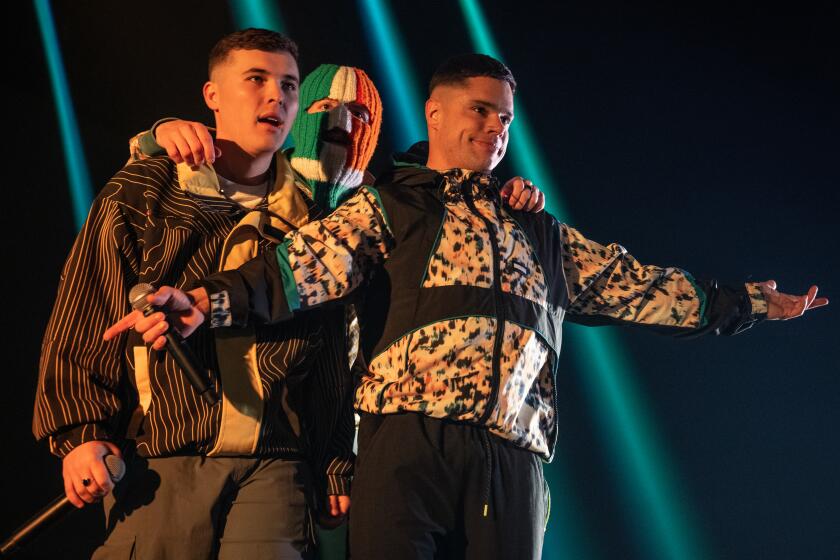POP MUSIC REVIEW : Santana Proves You <i> Can</i> Go Home Again
- Share via
TIJUANA — Hemingway would have hated it: On Saturday, 17,000 people were crammed into a sun-baked Tijuana bullring, and the predominant vibe was not machismo blood lust but a ‘60s-style medley of peace, love and brotherhood delivered on convulsive waves of music.
The occasion was a “Regresa a Casa” (“Homecoming”) concert by Carlos Santana in the border town’s Bullring by the Sea. The performance (scheduled to be repeated on Sunday) fulfilled the 44-year-old guitarist’s long-held dream of playing in the city of his youth. The shows had generated a great amount of civic pride among Tijuanans, who broke with their day-of-show tradition to purchase advance tickets by the thousands. A portion of the weekend’s proceeds was donated to a Mexican children’s charity.
For Saturday’s concert, a binational crowd virtually filled the wood-and-cement bowl usually devoted to afternoon corridas . Long before the music began at 3 p.m., the assemblage’s festive mood made it obvious that this would be as much fiesta as rock concert. Santana made the event even more reminiscent of the rock festivals of the late ‘60s with a generous survey of his 23-year oeuvre that kept the revelers dancing, cheering and singing along for almost three hours.
Although in years past the bullring occasionally hosted concerts by Latin artists, this was the first rock show to be staged there since the late ‘60s. Accordingly, Saturday’s event was not without its glitches. Volunteers and Mexican police monitored the seating, resulting in chaos that rivaled Tijuana’s notorious vehicular traffic.
The event, nonetheless, was a spectacular success, especially artistically, and bodes well for future shows at the unusual venue.
With the steeply inclined permanent seats all but swallowing the small infield area, the bullring at first appeared too compact for a large-scale rock show. Once the stands were filled with fans, however, that closeness translated to an unusual intimacy for so huge a throng, as well as a decent perspective even for those in the uppermost seats.
The concert opened with a set by Tequila, the local mariachi band, featuring guest violinist Jose Santana, Carlos’ father. Whereas mariachi musicians frequently serve as little more than window-dressing at Stateside functions, here they were highly regarded performers whose selections were lustily cheered. Second on the bill was reggae singer Pato Banton, who made a bizarre entrance by climbing out of the stands and rushing the stage while his band was playing. This caused temporary confusion among Mexican police and fans alike, but Banton’s 45-minute performance was well-received.
At 5:30 p.m., Santana entered from the tunnel normally used by the picadores --the lance-wielding horsemen in a bullfight. A thunderous ovation greeted this native son, who cut his musical teeth on Tijuana’s streets, performing on violin for turistas in the late ‘50s and later playing blues guitar in local clubs before moving to the Bay Area as a teen-ager.
After a brief speech in Spanish, Santana and his seven-piece band launched into a frenetic version of “Spirits Dancing in the Flesh,” and the fiesta kicked into high gear. During Santana’s first guitar solo, balloons of Mexico’s and the United States’ colors were released to loud cheering, underscoring the brotherhood theme. But the guitarist who popularized the fusion of Latin music and rock more than two decades ago was not about to stand on ceremony.
Passionate playing always has been Santana’s signature, but on this occasion he apparently tapped a vast reserve of emotion. On turbocharged renditions of such favorites as “Black Magic Woman,” “No One to Depend On,” “Oye Como Va,” and “Soul Sacrifice,” Santana seemed to draw on the crowd’s voltage, playing with an intensity that threatened to exceed even his considerable dexterity.
There would be poignant moments, including Santana’s heartfelt dedication of the song “Somewhere in Heaven” to his late comrades Stevie Ray Vaughan, Bill Graham and Miles Davis. But the guitarist’s omnipresent smile, his frequent waves and gestures to the crowd, his addressing many of the Spanish lyrics in his songs to members of the audience and his high-energy performance were all evidence that Santana’s homecoming was nothing less than joyous.
More to Read
The biggest entertainment stories
Get our big stories about Hollywood, film, television, music, arts, culture and more right in your inbox as soon as they publish.
You may occasionally receive promotional content from the Los Angeles Times.









